In 2006, we found and restored a 12-foot 1956 Liteweight Kiwi. It was the last Kiwi designed and hand built by my father in our home garage.
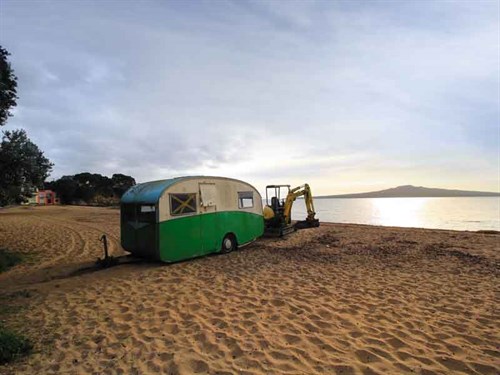
Dad built 82 caravans there over a 10-year period, before opening a factory and employing staff. We still have this caravan and have covered over 20,000 kilometres around New Zealand since its restoration. It is our home away from home.
Ever since we bought the 12-foot Kiwi, we have been searching for either a 14-foot Kiwi, of which only 28 were built, or a 14-foot Liteweight Silver Cloud, of which 52 were built. So far only six Kiwi 14-footers and five Silver Clouds have been found. Unfortunately, none of them had come our way… until the arrival of Daisy Mae.
Finding Daisy Mae
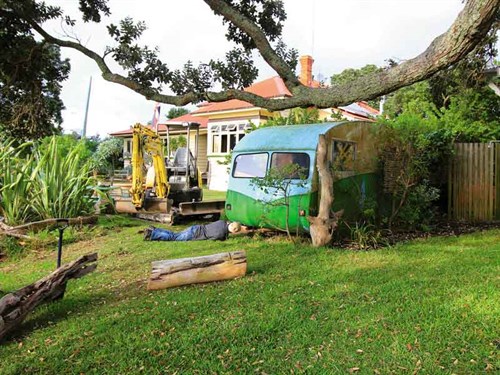
A friend spotted a 14-foot Liteweight Kiwi at Cheltenham Beach on the North Shore of Auckland in 2014. It was sitting on the front lawn of a home about two metres from the sand and four metres from the sea at high tide.
It had obviously been sitting there for many years. There were multiple layers of hand paint on the body, but the panel work was straight. The furniture was almost complete, although run down, and it had three cracked windows and missing window stays. As no one was around, I left my card in the letterbox with a note on the back explaining who I was and that my dad had designed and built the caravan.
In March 2016, completely out of the blue, the owner rang me, saying she was considering selling her Kiwi as it was deteriorating and getting beyond her abilities to fix. She said she loved the caravan, but would like to see it go to someone who could restore it back to its former glory.
We purchased the caravan, and conned Gary, Marilyn’s brother, to help us extract it with his digger. The extraction could only be done via the beach. Using strops, we pulled the caravan sideways, as it was hard up against a neighbour’s fence.
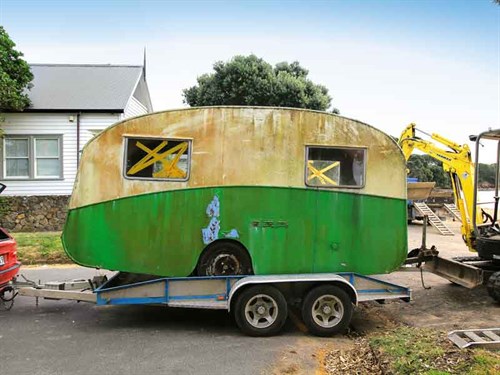
Then we dragged it out backwards, using the boom of the digger to push aside the protected pohutukawa tree branches that were impeding our exit out to the sand. While it sounds complicated, the caravan actually came out much more easily than we expected.
The two-hour trip home was uneventful, but as we unloaded it at my friend’s caravan factory, the drawbar collapsed. The rust had finally stopped holding hands.
In the process of moving the caravan, one of the rusty hubcaps fell off, and we discovered that the name ‘Klein’ was painted inside alongside the word ‘Reward’ and a very old five-digit phone number.
At home later, we got out Dad’s old order books and went through them. There, in 1958, was a page devoted to a Mr Klein buying one 14-foot Kiwi.
The details matched our new acquisition perfectly. It is chassis number 147. We christened it Daisy Mae after Marilyn’s auntie, who in her early days was the steady girlfriend of my Uncle Jim. Small world!
The restoration
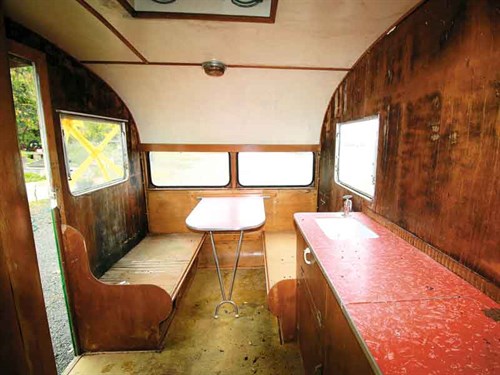
We did not start the restoration until October 2016. The first thing we did was get the caravan up onto stands so that we could have a good look at the chassis. We hit it with a wire brush and great flakes of rust fell to the floor. Surprisingly, under the flaky rust the centre of the chassis, along with the axle and springs, appeared to be quite clean and certainly redeemable.
A sandblast and rustproofing was sufficient to bring it back to life. The Oregon timber bearers were in excellent condition at the rear, while the front ones had some cracks and needed strengthening. The rear and front chassis steel, including the drawbar, were chuck-away material. Unfortunately, the coupling and jockey wheel winder were also past redemption.
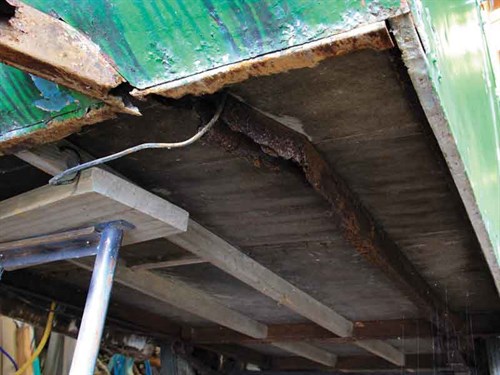
Dave McRobbie, who owns Caravan & Motorhome World in Hamilton, was entrusted with the job of rebuilding the chassis, with Don helping him out. The drawbar and 500 mm of the chassis were cut away then used as a pattern for a new drawbar and chassis.
These were then built and scarfed into the existing chassis with a 500 mm overlap, making the chassis stronger than the original. We had managed to buy a reasonably vintage-styled new coupling and jockey wheel winder. We fabricated the front of the drawbar/coupling area as per the original style incorporating the new fittings, and stamping the drawbar with its original chassis number—147.
While working on the chassis, we also removed the opening alloy window frames and had them machine polished. They came up like chrome. This all sounds like it was pretty easy, but in fact the window frames were badly corroded, the pan-head screws often broke, and had to be drilled out.
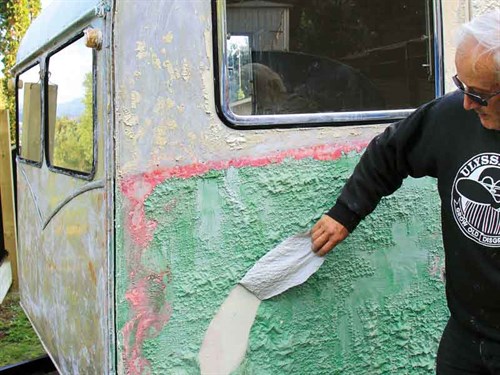
It was a time-consuming job, but the resulting finish was well worth the frustration. We also removed the waist mouldings and stripped the paint off them to reveal pristine chrome underneath. I sourced new cross-ply vintage tyres from Classic Tyres, out of Tauranga, along with 3-inch whitewall flappers.
Today in New Zealand, our vintage caravans have to have indicators, brake lights and front sidelights. Replica 1939 Ford Teardrop tail lights were sourced from Ajay’s Ford V8 Parts in Waihi.
These lights are LED and combine indicator, brake and tail lights all in one. A central replica tail light of a Model-A tail/stop/number-plate light with number-plate bracket was also sourced from Ajay’s.
By the end of November, the chassis had been sandblasted, rustproofed and enamelled in black. We overlaid the spongy ply floor with another layer of plywood to strengthen it. The opening side windows were rerubbered and reglazed.
The window frames were temporarily fitted and came out again for painting. We took it in for a warrant of fitness—the Kiwi equivalent of the Australian roadworthy certificate— and it passed with flying colours.
Over Christmas, many discussions were had about the interior. It was missing the original overhead cupboard and power, and we also wanted to fit a shower and toilet, while at the same time retaining the original look.
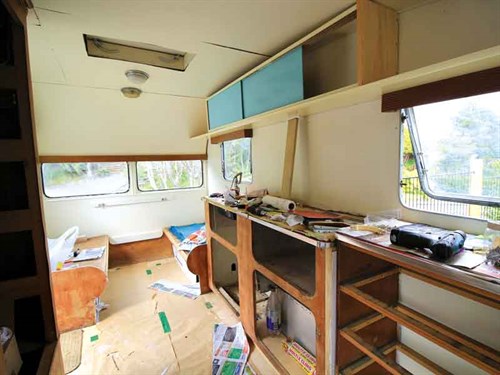
We decided to swap the lowboy to the offside and fit the shower and toilet in its place, continuing the same curved corner as featured on the wardrobe. The fitting of the shower and lowboy necessitated narrowing the rear bunk slightly.
Towards the end of April, we managed to spend a week on the Kiwi, stripping five layers of paint from the exterior to bring it back to bare aluminium in preparation for painting. For anyone who has done a similar job on their own caravan, you will know how tiresome this job is. It has to be the worst job to do when restoring a caravan!
The furniture was built in kauri ply and varnished. We did some intricate surgery to the sink bench—fitting a fridge, enlarging one of the cupboards, and fitting curved ends to its carcass.
We created a full-length overhead cupboard and china cabinet in the style of the originals. The sliding door frame from the back bunk was utilised for the central cupboard of the overhead. Additional drawers were made from folded aluminium, in standard Liteweight style for more convenient storage.
We had decided that this van would become our main touring van, and were keen to make it as off-the-grid as possible. We retained the gas for cooking, and added a califont for heating water. In the back of our minds was the possibility of doing a 365-day tour of New Zealand, so we also bought a gas Propex HS2000 heater, to keep us warm and toasty through winter.
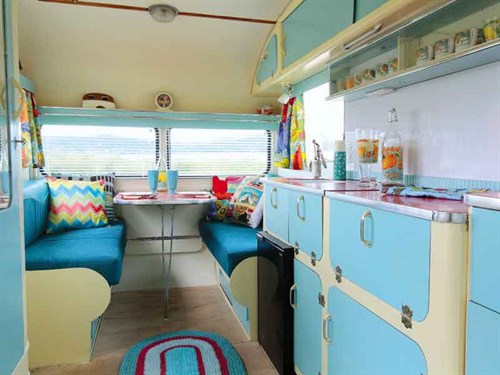
We also wanted a comprehensive 12-volt system, so we installed a flexible 100-watt solar panel, from Jaycar, behind the roof vent, where fortunately it can only be seen from above. It was really important to us that the modern conveniences did not impact on the vintage look of the caravan.
We wanted to install the fridge under the sink, so size and low draw were the key criteria in our decision making. We chose a 60-litre Vitrifrigo fridge from Camec. We also made the decision to create a side-vented, old-fashioned safe drawer under the front bunk to make up for the smallness of the fridge.
In addition to the fridge, the 12-volt system will run lights, a 12-volt pump for the shower, and USB and cigarette lighter sockets for charging devices. The caravan had been stripped of its 240-volt system, so we rewired it and added one central light and some power outlets for the rare occasion we stayed in camping grounds.
By the end of May 2017, we were ready for lino and exterior painting. In June, Marilyn designed and made retro dinette squabs and new curtains.
A friend, Mike ‘Wellsy’ Wells, who owns Retro Custom Caravans in Whakatane, suggested we bring Daisy Mae down to his shop for painting. July saw a final coat of stripper applied, then the bodywork was sanded and faired before being etched, undercoated and painted in 2pac high gloss.
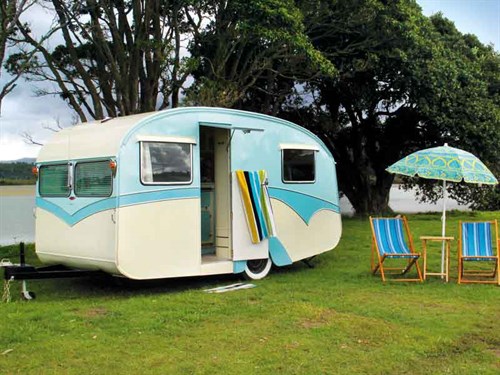
Marilyn had chosen the exterior colours and I had designed the streamline. Mike and his team, Shannon and Logan, made an awesome job of the caravan and we both think it looks stunning in its two-tone turquoise and cream livery. While there we also fitted the chrome work, retro front sidelights and rerubbered the front and rear windows, replacing the glass with green-tinted windows.
Back at home we completed painting the new overhead cupboard. We still have the shower cubicle and back bunk to construct and the plumbing and heater to fit, along with laying the lino. On the exterior there are varnished timber rub rails to fit on the lower side panels and we plan to fit a travel box on the drawbar and a folding stainless steel luggage rack to the rear of Daisy Mae.
We have absolutely no doubt that we will come up with other bright ideas in the meantime, so we will just keep on enjoying restoring our 1958 Kiwi.





